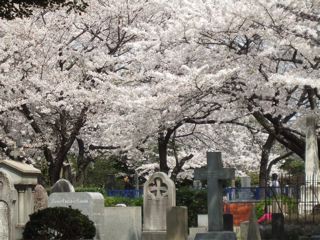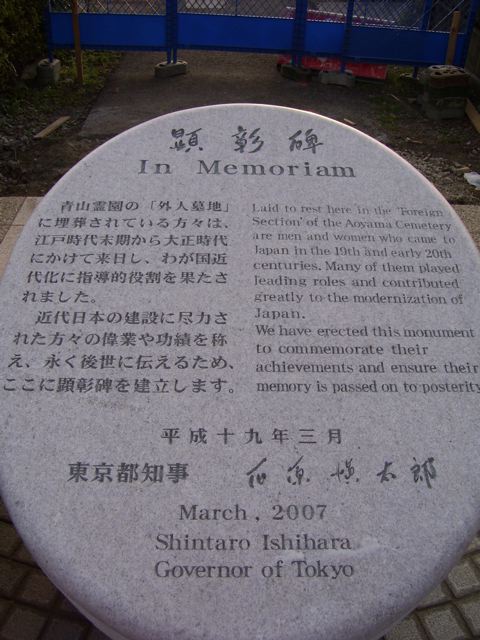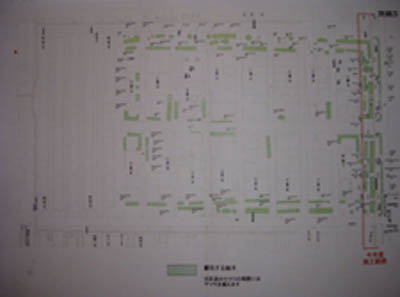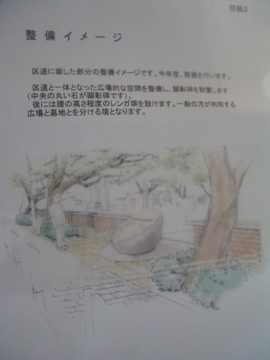O-hanami -- 2009, March 29
It's o-hanami season again!
Sorry for the short notice, but the blossoms are appearing even earlier this year. Please join us and feel free to invite your friends:
DATE: Sunday, March 29 -- no rain date
TIME: 11:00 a.m. to dusk
PLACE: Aoyama Cemetery, south side of the Foreign section
(same place as last year under the early blooming tree)
View map of the area (The cross hairs indicate the approximate location of "the tree".)
View close up of the area.
WHAT TO BRING: Your favorite food and drink and a cushion. If you are coming in a group, please bring a ground sheet and, in any event, help to clean up before you leave.
Please let me know if you are going to attend: jonathan at foreignsection.org
Posted by Jonathan on
March 26, 2009
O-hanami 2008, March 30
The 2008 hanami is scheduled for Sunday, March 30, a bit earlier than last year's. It will be in the same location, near or under the early blossoming tree.
Time: 10:00 - 16:00
Place: The South side of the "Foreign Section" in Aoyama cemetery
View map of the area (The cross hairs indicate the approximate location of "the tree".)
View close up of the area.
What to bring: Family and friends, your favorite food and drinks, and a cushion, if you want to sit comfortably.
Rain Date: There isn't one. Bring an umbrella!
If you have any questions, send e-mail to me: jonathan at foreignsection dot org. Would also appreciate you letting me know if you will attend.
Posted by Jonathan on
March 24, 2008
New sign

Information about the Foreign Section has been etched into a new metal sign to the left of the memorial stone.
Close-ups of parts of the sign and accompanying higher resolution pictures are below:

The text at the top of the sign. A higher resolution picture is here.
(Roughly translated) In Meiji 10, the Foreign Section was established and designated as an area for burial of foreigners in Aoyama cemetery. The first burial was in Meiji 13. After Meiji 32, it lost its special status and became part of Aoyama cemetery. The people who contributed to the modernization of Japan and their families are buried here. The graves are maintained by their descendants and relatives. The graves which don't have anybody to pay their maintenance fees after Heisei 18, are in the custody of Tocho. The unique headstones reflect the pride and caring of the families and friends that erected them. You are invited to walk around and discover the people who helped to modernize Japan, how their families and friends felt about them, and the era. (A better translation would be welcome!)

A list of important people and their location in the Foreign Section is on the bottom left of the sign. A higher resolution picture is here.

A map of the entire Foreign Section is in the bottom right of the sign. Higher resolution picture is here.
This map replaces the old map. Notice that although the layout of the plots is essentially the same as in the the old map, the old one has the names of the important people AND "unimportant" people. This erasure of the "unimportant" people from the public record is of concern.

A letter requesting approval for the establishment of the Foreign Section to the Central govt. from Tocho and the central govt's approval is in the middle of the sign. A higher resolution picture is here.
Posted by Jonathan on
December 28, 2007
Construction (round 2)

This shot of the 2nd phase of construction was taken from the road at the South end of the Foreign Section, looking West down the path passing under the early blooming cherry tree . (The stump of an uprooted tree is on the bottom right. The trunk of the early blooming cherry can be seen in the top left.)
The second round of construction will improve visibility and access to the plots and stones through the removal of greenery and benches, and laying of cement walkways.

The construction will be completed at the end of February 2008 at a cost to taxpayers of nearly 45 million yen. See a close up of the sign.

This view is of a space that had a bench and was full of bushes right next to the spot where we hold hanami. We'll just have to wait and see what it looks like in early April when the cherry blossoms open.
Posted by Jonathan on
December 27, 2007
Monument unveiling 2007.4.4

Tocho officials unveiling the monument commemorating the achievements of the foreigners who came to Japan in the 19th and 20th century.

The dedication ceremony commemorating the contribution of foreigners to the modernization of Japan was lightly attended by about 20 relatives and friends of the deceased.

Cherry blossom petals showered the event; the wind blew them into pink petal drifts. Also in attendance were about 20 functionaries from Tocho's Parks and Cemeteries Construction section, and again about the same number of press, including representatives from some of the major TV stations. Notably absent was Tokyo Governor Ishihara who commissioned the stone. It seems odd that he would recognize the contribution of foreigners then not show up. Is this in character with his well-documented xenophobic, anti-foreigner stance? On the other hand, it may not be so odd -- it is Ishihara using one stone (so to speak) to kill two birds : by not showing up, he his distancing himself from the sentiment displayed on the stone, satisfied that future generations' view of him will be enhanced AND the memorial can be used quietly to subsume the graves of "unimportant people" which is the intent of erecting the stone to begin with....
The ceremony ended with a distribution of souvenirs.
Posted by Jonathan on
April 22, 2007
O-hanami 2007 Pictures

Trees in full bloom in the morning of the 2007.4.1 hanami in the Foreign Section of Aoyama cemetery.
O-hanami 2007 was a great success with many familiar faces, some 40 adults, a couple of children, and a dog hanging out over the course of the day. As usual. the food was fantastic and the wine plentiful. Thanks to all who came and sorry there aren't more pictures to put up:


Although the construction was finished, as you can see the ambiance was marred by the barriers which had been left up. Our tree had passed its peak, and was showering us with its delicate pink petals, but the trees nearby were in full bloom.
Posted by Jonathan on
April 21, 2007
Monument unveiling schedule

The backside view of the monument re-wrapped.
The ceremony for the unveiling of the monument will be held on April 4 at 10:00 a.m. We've been told that those who are paying the fees for the plots have been invited, but Governor Ishihara will probably not attend.
Posted by Jonathan on
April 3, 2007
O-hanami 2007
The 2007 hanami is on for Sunday, April 1 and we hope you will join us near or under the tree that blooms early. While "the tree" will have already lost many of its blossoms, there are sure to be others peaking in the vicinity, affording the proper ambiance for revelry and reflection on the bittersweet transience of both cherry blossoms and life.
Time: 10:00 - 15:00
Place: The South side of the "Foreign Section" in Aoyama cemetery
View map of the area (The crosshairs indicate the approximate location of "the tree".)
View close up of the area
What to bring: Family and friends, your favorite food and drinks, and a cushion
If you have any questions, send e-mail to me on fst at foreignsection dot org. We hope to see you there.
Posted by Jonathan on
March 26, 2007
The scoop on the Monument

Debris litters the "Foreign Section" construction site as the facade nears completion. Memorial is in the center of the frame behind the pair of orange cones.
Here is a close up of the monument.

The English side says (and this is a scoop):
Laid to rest here in the 'Foreign Section' of the Aoyama Cemetery are men and women who came to Japan in the 19th and early 20th centuries. Many of them played leading roles and contributed greatly to the modernization of Japan. We have erected this monument to commemorate their achievements and ensure their memory is passed on to posterity. March , 2007 [sic]
The sentiment somewhat fits with what we have been saying on this website, however, we note that Tokyo Governor Ishihara has killed two birds with one stone at taxpayer expense: he offsets his well-documented racist remarks directed at foreigners living and working in Japan, and at the same time sets the groundwork for future bureaucrats to remove graves.
On balance though — and this is very good news — it seems that after our repeated calls for documentation on Tocho's intention to preserve all the graves, Tocho in January of 2007 made a document stating it will do so. (The document will be uploaded to this site when it's translated.)
Posted by Jonathan on
March 25, 2007
Construction started

Removal of bushes and stonework in preparation for construction of a viewing platform and Ishihara's proposed memorial started sometime in the week of JAN 22, 2007.
Below is a before picture, not quite from the same angle as the above, but the street light in both pictures is a good reference point.

Coincidentally, there is an article (republished in pdf with no permission and for no monetary gain) in today's The Japan Times on the fate of another park in Okubo that eerily echoes what has happened -- the voice of taxpayers left unheard while those of associations were heeded -- and what may be in store for the Foreign Section.
Publishing our letter here as promised is moot, but just for the record, here it is in both English and Japanese:
Further explanation and progress
Further explanation of Tocho's rationale for removing bushes and benches in the Foreign section has come to light:
Briefly, the removal of bushes and benches is also to make it difficult for homeless people to move in.
As far as progress in our communications with Tocho, in response to the earlier explanation below and the above addition, a letter has been sent, which will also appear in its entirety with the English version here soon. In addition, a press release is available upon request.
Posted by Jonathan on
January 26, 2007
Tocho explains their plans.
Tocho's plan is to create more parkland in Tokyo by refurbishing Aoyama Cemetery. They are now executing their plan to repurpose the cemetery and will turn the Foreign Section into an attraction in the cemetery.
Specifically, Tocho plans to renovate the area between the sidewalk and the first row of plots to create a viewing platform from which visitors can see the gravestones. Because the land slopes downward into the Foreign Section, the platform will require a protective barrier, steps and ramps to provide access to the cemetery. They will try to use materials that look natural.
Building the platform necessitates the removal of the bushes along the sidewalk. In addition, bushes and trees within the Foreign Section will be removed so that when people snap a photo they will get pictures of the stones, not shrubbery. Tocho plans to plant grass where trees and bushes are removed.
The land where the platform is proposed (as well as some other areas within the Foreign Section) is owned by Tocho, so they do not require permission from plot owners to remove the sidewalk bushes. They have notified owners of plots whose greenery may be removed and have received no complaints so far. Perhaps people using the graves will be happier without trees and bushes because they won't need to remove dead leaves. Tocho doesn’t know which trees are from the Meiji era, but says that some of the trees and plants will be replanted elsewhere in the cemetery and the remainder will be turned into chips or fertilizer.
Tocho is going to make a new sign about the people in the Foreign Section, but they know not when. A pamphlet about some of the famous people in Aoyama Cemetery was made last summer. Further "software things" are under discussion, but no decision has been made about funding historical research, or if the historical information could be disclosed.
Tocho added that there is a regulation giving Tocho the right to remove stones, graves, and bones if maintenance fees are not paid for five years, but Tocho decided in a meeting that they would not remove any gravestones from the Foreign Section when the right to use the land reverts to Tocho. These meeting minutes exist, but they must be requested through a "freedom of information form.” We requested meeting minutes via the form, but our request was denied.
Tocho explained that the only way to temporarily stop the construction is if a bomb is found on the site, or if a politician talks about it in the Diet, or many people demonstrate in front of the office in charge of construction.
End Tocho's explanation
Posted by Jonathan on
January 22, 2007
Further removal of greenery
In character with the Cemetery and Parks division's modus operandi of withholding information until it is a done deal, we received the other half of the plans on TUE:

This bird's eye view of the Gaijin bochi shows that virtually all of the bushes and some trees will be removed. We understand that this is to provide an unobstructed view of graves, which in of itself is not necessarily a bad thing, but we believe the charm of the cemetery will be lost.
We urge you to write to Tocho and Governor Ishihara to call for a halt to these plans and preservation of the site.
1) Tocho's e-mail: koe AT metro.tokyo.jp
(Please cc sachiko AT foreignsection DOT org so that she can also forward your mail to the Parks and Cemetery division.)
2) Governor's snail mail: Governor Shintaro Ishihara, 2-8-1 NishiShinjuku, Shinjuku-ku, 163-8001.
Details from TUE's meeting are forthcoming.
Posted by Jonathan on
January 18, 2007
Facade construction plans
The last four months of 2006 were uneventful, yet a bit frustrating, because it was only after repeated requests for documentation on Tocho's plans for the Gaijin bochi that they finally released the drawings for the budgeted construction.
The release of the plans came AFTER Tocho issued a tender, received bids and chose a contractor.

The artist rendering shows that bushes will be replaced by what appears to be a facade that is intended to raise the visibility of the Gaijin bochi. A monument and low wall will be constructed and cement and tile laid. What you can't see are the planned steps and ramps for wheelchair access leading into the foreign section just behind the monument and what might be inscribed on it.
We recognize that the construction plan is in line with Tocho's promise not to move or remove graves for the time being, but the planned construction makes the cemetery less green, and provides for no historical preservation.
Here is our response to Tocho's plan in English and Japanese.






















